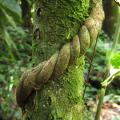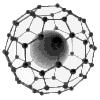
DMT-Nexus member
Posts: 1111 Joined: 18-Feb-2017 Last visit: 12-Jul-2024
|
I performed an experiment suggested here by downwardsfromzero: downwardsfromzero wrote:
From my understanding of chemistry, the reaction in the direction of harmine seems more favourable. However, I do recall reading that the reaction was pH dependent, and that low pH favoured the reduction of harmaline to THH, whereas high pH favoured the oxidation of harmaline to harmine. This may have been in Shulgin & Shulgin's "TIHKaL". [..]
My outline thoughts are that ascorbic acid (vitamin C) could act as a hydrogen transfer agent by shuttling between the reduced state and dehydroascorbic acid. Certain metal ions or catalytic metals could assist in this process.
A few calculations and some experimentation would need to be done to test this hunch. It's something I've been visualising on a molecular level for quite some time now. I mean, it could be rather wide of the mark in practice but it's clearly energetically favourable from a chemistry point of view.
Here is what I did:
- Dissolved 2 grams of harmaline freebase in a small amount of vinegar.
- Dissolved 2 grams of ascorbic acid in water.
- Poured the dissolved ascorbic acid into the harmaline.
- The pH was in the 4's due to the ascorbic acid; I added sodium bicarbonate to bring the pH to 6. I wanted high pH to favour the oxidation to harmine. But I wasn't sure how high it would have to be, and how to 'marry' a high pH with ascorbic acid, which - being an acid - lowers the pH. I understand much of the ascorbic acid converted to sodium ascorbate, which might not have retained the properties we want for the decarboxylation to take place.
- Added tap water to increase the volume to my pressure cooker's required minimum, and boiled this in the PC. The PC's highest time setting is 37 minutes, so I did 30 such cycles.
- Based with ammonia and pushed the remaining alks out with NaOH, then washed that.
- Dried the freebase.
Now, the dried freebase is *much* darker than the original harmaline, which was cream / golden. This is brown, more like harmine, but even darker and with a red, rusty tinge. Surprisingly, the weight has increased from 2g to 2.1g. The scale used is only 0.1g accurate, but still I would have expected some losses, and definitely not an increase. Also, harmaline, harmine and THH have all very similar molar mass, so it can't be the case of a molecule adding weight. It must be contamination then? Also, while basing with ammonia, I tried to do pH-based harmine/harmaline separation. It didn't quite work - it didn't seem to cloud until the pH reached 9 or so. But that doesn't prove there is no harmine in it. The separation works best on clean solutions with just harmine and harmaline, and this solution contained sodium ascorbate, which may have interfered with precipitation and changed the pKa's. I can still dissolve this freebase and attempt separation on a cleaner solution. But a bioassay will probably come first.
|
|
|
|
|

DMT-Nexus member
Posts: 14191 Joined: 19-Feb-2008 Last visit: 22-Nov-2025 Location: Jungle
|
Thanks for experimenting and sharing!
I highly recommend you to get into TLC, it would solve questions like this really easily.
You could even potentially do some sort of improvised paper chromatography.
|
|
|

DMT-Nexus member
Posts: 1111 Joined: 18-Feb-2017 Last visit: 12-Jul-2024
|
endlessness wrote:I highly recommend you to get into TLC, it would solve questions like this really easily. Thanks, I guess I will eventually, but it's a new world and the initial learning curve has been holding me back. Here is a side-by-side visual comparison: harmaline on the left, and the result of the experiment on the right. Tiny bits only, just to show how much darker the latter is. Sodium ascorbate is white, so it couldn't have darkened it? Jagube attached the following image(s):  dhh-vs-unknown.jpg (131kb) downloaded 179 time(s).
|
|
|

DMT-Nexus member
Posts: 14191 Joined: 19-Feb-2008 Last visit: 22-Nov-2025 Location: Jungle
|
Jagube wrote:endlessness wrote:I highly recommend you to get into TLC, it would solve questions like this really easily. Thanks, I guess I will eventually, but it's a new world and the initial learning curve has been holding me back. Here is a side-by-side visual comparison: harmaline on the left, and the result of the experiment on the right. Tiny bits only, just to show how much darker the latter is. Sodium ascorbate is white, so it couldn't have darkened it? It is very easy, I think you're overestimating the learning curve, if you do extractions you already do more complicated things. You just add your dissolved substance to your tlc plate, put it in a box until you see the absorbed solvent get to the top of the plate, let it dry and look under UV light. With harmalas, normal long-wave UV light (the one used at parties) works fine. This video gives an overview Here's how harmalas look under UV, notice the big difference between the harmine dark blue shine on top and the harmaline light blue shine, no way to mistake them: 
|
|
|

DMT-Nexus member
Posts: 557 Joined: 12-Jul-2012 Last visit: 01-Jan-2021
|
The darkening of the product likely occurred due to decomposition/polymerization of dehydroascorbic acid and ascorbic acid. In organic chemistry such byproducts are refereed to as 'crap'.
You can remove the crap from your product by a few manske cycles or recrystallization.
|
|
|

Chairman of the Celestial Divison
  
Posts: 1393 Joined: 21-Jul-2010 Last visit: 11-Aug-2024 Location: the ancient cluster
|
Auxin wrote:The darkening of the product likely occurred due to decomposition/polymerization of dehydroascorbic acid and ascorbic acid. In organic chemistry such byproducts are refereed to as 'crap'.
You can remove the crap from your product by a few manske cycles or recrystallization. Yeah, if you even leave a bottle of ascorbic acid out open to the air, it quickly turns brown. TLC is by the far the simplest way and also offers strong evidence for the conversion to a product, especially in the case of harmalas. Pretty much any other evidence you could come up with by simple means is not nearly as concrete, not even close. Expect nothing, Receive everything.
"Experiment and extrapolation is the only means the organic chemists (humans) currrently have - in contrast to "God" (and possibly R. B. Woodward). "
He alone sees truly who sees the Absolute the same in every creature...seeing the same Absolute everywhere, he does not harm himself or others. - The Bhagavad Gita
"The most beautiful thing we can experience, is the mysterious. The source of all true art and science."
|
|
|

❤️🔥
 
Posts: 3648 Joined: 11-Mar-2017 Last visit: 26-Nov-2025 Location: 🌎
|
Mindlusion could using Platinum black help our friend here? The neat thing about platinum black catalyst is that it is very OTC, used for breaking down H2O2 in contact lens solutions. I wonder if it could help change Harmine into Harmaline or vice versa (or both). Any thoughts?
|
|
|

Chairman of the Celestial Divison
  
Posts: 1393 Joined: 21-Jul-2010 Last visit: 11-Aug-2024 Location: the ancient cluster
|
I think it could definitely work. Palladium black is often used for this kind of dehydrogenation But conditions might need to be intense, standard conditions for this transformation are reflux in xylenes (b.p. 155C). Some cases elemental sulfur can be used too, which is cheap and OTC. Expect nothing, Receive everything.
"Experiment and extrapolation is the only means the organic chemists (humans) currrently have - in contrast to "God" (and possibly R. B. Woodward). "
He alone sees truly who sees the Absolute the same in every creature...seeing the same Absolute everywhere, he does not harm himself or others. - The Bhagavad Gita
"The most beautiful thing we can experience, is the mysterious. The source of all true art and science."
|
|
|

Boundary condition

Posts: 8617 Joined: 30-Aug-2008 Last visit: 13-Nov-2025 Location: square root of minus one
|
Thank you so much for trying my suggestion! Decomposition of ascorbic acid is of course greatly accelerated by heat and oxygen to name but two; this might bring problems as the dehydroascorbic acid will be rather electrophilic and may well be reacting with some of the harmala alkaloids. This can happen either on the ring or on the 1-methyl group, and might explain the nature of some of the crud increasing the yield weight. Typically people want to achieve their goals within a reasonable time frame of, say, a couple of days; some reactions take place very slowly at lower temperatures - but they avoid the decomposition/side reactions that would occur during heating. To wit, it seems my 2-years-refrigerator-stored rue brew with added ascorbic acid (preserved with ethanol, in case anyone wondered!) should be ripe for analysis soon. Given that P. harmala typically contains only minimal amounts of THH it will be interesting to see whether there is any significant amount of THH to be found after being subjected to these very mild conditions for a relatively very long time period. (Lack of a control for comparison is of course a bit a devaluation of my experiment.) Ideally this process will involve chromatography but due to lack of funds at the present time, the media will have to be prepared from available materials which will further add to the time frame. “There is a way of manipulating matter and energy so as to produce what modern scientists call 'a field of force'. The field acts on the observer and puts him in a privileged position vis-à-vis the universe. From this position he has access to the realities which are ordinarily hidden from us by time and space, matter and energy. This is what we call the Great Work." ― Jacques Bergier, quoting Fulcanelli
|
|
|

DMT-Nexus member
Posts: 1111 Joined: 18-Feb-2017 Last visit: 12-Jul-2024
|
Thanks guys for the ideas. I'm specifically interested in the harmaline -> harmine direction here. If an OTC process can be developed that disproportionates harmaline to harmine and THH at a ratio of (at least) 1 part harmine to 2 parts THH, I'd be happy with that too. Mindlusion wrote:Some cases elemental sulfur can be used too, which is cheap and OTC. I have 99.99% pure flowers of sulfur, which I bought to treat the cuts on my San Pedros, so might try that on another occasion. downwardsfromzero wrote:Typically people want to achieve their goals within a reasonable time frame of, say, a couple of days; some reactions take place very slowly at lower temperatures - but they avoid the decomposition/side reactions that would occur during heating. The slow way is acceptable too if it can produce harmine and the time frame is only a couple of years. My seeds contain much more harmaline than harmine, so every time I extract, I store the excess harmaline away as there is not much else I can do with it anyway. I wouldn't mind setting it up for conversion to harmine if I knew it would work. If you do test your old sample, please do let us know. As for the current product, I guess the order will be something like this: - Bioassay (assuming no dangerous byproducts here?) - Dissolve in vinegar, filter and attempt ammonia-based separation again - Manske and take it from there (possible outcomes: cleans up and makes separation easier; OR reveals the harmaline converted into something that doesn't even Manske-precipitate) I understand TLC doesn't show quantity, and traces of harmine may have been present in the original harmaline sample, so that wouldn't reveal much? I've also just ordered a USB microscope, so will play with that when it arrives. I have harmine, harmaline and THH to serve as controls for comparison.
|
|
|

DMT-Nexus member
Posts: 14191 Joined: 19-Feb-2008 Last visit: 22-Nov-2025 Location: Jungle
|
TLC shows quantity, the larger the spot, the more of that alkaloid there is, so its easy to see if the conversion worked, you'll see a clear reducing (or total dissapearing if it worked totally)of size of one spot, and increasing in size of other spot
|
|
|

DMT-Nexus member
Posts: 1111 Joined: 18-Feb-2017 Last visit: 12-Jul-2024
|
I've done two bioassays of the brown powder: sublingual 70 mg and oral 210 mg; the latter with Chaliponga tea. Both felt like harmine and not harmaline  The DMT got activated and I didn't experience the light-headedness I get from harmaline. This is very promising and has encouraged me to proceed with further verification, the next step being Manske and an attempt at pH-based separation.
|
|
|

Chairman of the Celestial Divison
  
Posts: 1393 Joined: 21-Jul-2010 Last visit: 11-Aug-2024 Location: the ancient cluster
|
Jagube wrote:I've done two bioassays of the brown powder: sublingual 70 mg and oral 210 mg; the latter with Chaliponga tea. Both felt like harmine and not harmaline  The DMT got activated and I didn't experience the light-headedness I get from harmaline. This is very promising and has encouraged me to proceed with further verification, the next step being Manske and an attempt at pH-based separation. Bioassay is not good evidence. Subjective experience can be significantly altered, especially if you are expecting a certain result. That's why they do 'double-blind'. TLC is the strongest form of evidence you can offer here, microscopy of the crystals is ambiguous since your dealing with mixtures already. Manske as well, tells you nothing except relative yield, which varies, if you are dealing with mixtures. By using TLC, if you are using pure harmaline, you should see the obvious presence of the bright blue harmine higher up on the plate. And if you are using a mixture, you should at least see a disappearance of the harmaline. The best way to test this would be to isolate harmaline via pH controlled base precipitation and then subject it to reaction conditions and monitor by TLC. Expect nothing, Receive everything.
"Experiment and extrapolation is the only means the organic chemists (humans) currrently have - in contrast to "God" (and possibly R. B. Woodward). "
He alone sees truly who sees the Absolute the same in every creature...seeing the same Absolute everywhere, he does not harm himself or others. - The Bhagavad Gita
"The most beautiful thing we can experience, is the mysterious. The source of all true art and science."
|